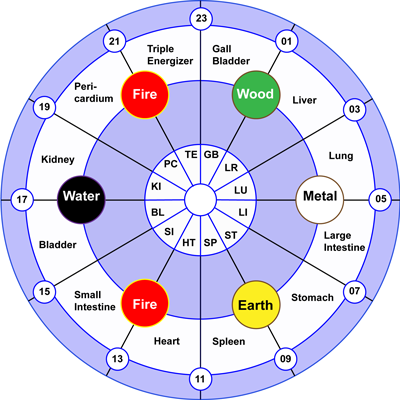Horary Clock
During a 24 hours cycle, energy flows in different organs demonstrated by the following chart.
|
Time |
Organ |
Function |
| 5-7 a.m. | Large Intestine | Drinking water triggers bowel evacuation making room for the new day’s nutritional intake. Removes toxins from the night’s cleansing |
| 7-9 a.m. | Stomach | Stomach energies are the highest so eat the most important meal of the day here to optimize digestion/assimilation. |
| 9-11 a.m | Pancreas | The stomach passes its contents on. Enzymes from the pancreas continue the digestive process. Carbohydrate energy made available. |
| 11 a.m.-1 p.m. | Heart | Food materials enter the blood stream. The heart pumps nutrients throughout the system and takes its lipid requirements. |
| 1-3 p.m. | Small Intestine | Foods requiring longer digestion times (proteins) complete their digestion/assimilation. |
| 3-5 p.m. | Bladder | Metabolic wastes from morning’s nutrition intake clear, making room for the kidney’s filtration to come |
| 5-7 p.m. | Kidney | Filters blood (decides what to keep, what to throw away), maintains proper chemical balance of blood based on nutritional intake of day. Blood to deliver useable nutrients to all tissues. |
| 7-9 p.m. | Circulation | Nutrients are carried to groups of cells (capillaries) and to each individual cell (lymphatic). |
| 9-11 p.m | Triple Heater | The endocrine system adjusts the homeostasis of the body based on electrolyte and enzyme replenishment. |
| 11 p.m.- 1 a.m. | Gall Bladder | Initial cleansing of all tissues, processes cholesterol, enhances brain function. |
| 1-3 a.m. | Liver | Cleansing of blood. Processing of wastes. |
| 3-5 a.m. | Lung | Respiration. Oxygenation. Expulsion of waste gases. |

